Jebel Hafeet
| Jebel Hafeet | |
|---|---|
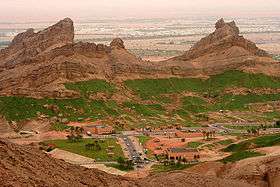 | |
| Highest point | |
| Elevation | 1,249 m (4,098 ft) |
| Coordinates | 24°03′31″N 55°46′39″E / 24.05861°N 55.77750°ECoordinates: 24°03′31″N 55°46′39″E / 24.05861°N 55.77750°E |
| Geography | |
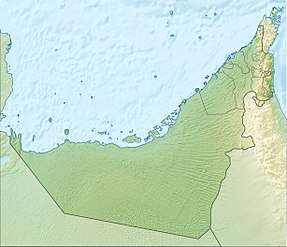 Jebel Hafeet United Arab Emirates | |
| Location | The United Arab Emirates and Oman[1][2] |
Jabal Hafeet (Arabic: جَـبَـل حَـفِـيـت, translit. Jabal Ḥafīṫ, "Mount Hafeet") (variously transcribed Jabal, Jabel or Jebal and Hafit or Hafeet – literally "empty mountain") is a mountain in the environs of the city of Al Ain in Eastern Arabia. Al-Ain is in the Emirate of Abu Dhabi,[3] on the United Arab Emirates' eastern border with Oman. Like Al Hajar Mountains, it is shared between the United Arab Emirates and Oman.[1][2]
The mountain has given its name to a period in UAE history, the Bronze Age (3200 to 2600 BCE) Hafit Period, because of the discovery of a cluster of important Bronze Age beehive tombs at its foothills.[4]
Climate
The Climate of Jebel Hafeet is Desert weather (Warm and Hot).[5] On Average there is 77mm of rain fall in a year. According to Köppen and Geiger, this climate is classified as BWh.[6] The temperature vary in different months on average but remain relatively cool in the months of October to March Where it remain below 25 °C. In other months it remain more then 25 °C. The average temperature is 27.1°C. Flow table show the average temperature of 1 year monthly.[5][6]
| Scope | Jan | Feb | Mar | Apr | May | Jun | Jul | Aug | Sep | Oct | Nov | Dec |
| Avg. (°C) | 20 | 20.9 | 23.8 | 27.8 | 31.8 | 33.3 | 32.2 | 31.1 | 30.1 | 28.3 | 24.5 | 21.9 |
| Min. (°C) | 14 | 15.2 | 18 | 21.1 | 25 | 26.7 | 26.4 | 25.5 | 23.8 | 21.5 | 17.8 | 15.9 |
| Max. (°C) | 26.1 | 26.6 | 29.7 | 34.6 | 38.7 | 40 | 38 | 36.7 | 36.5 | 35.1 | 31.3 | 27.9 |
| Avg. (°F) | 68 | 69.6 | 74.8 | 82 | 89.2 | 91.9 | 90 | 88 | 86.2 | 82.9 | 76.1 | 71.4 |
| Min. (°F) | 57.2 | 59.4 | 64.4 | 70 | 77 | 80.1 | 79.5 | 77.9 | 74.8 | 70.7 | 64 | 60.6 |
| Max. (°F) | 79 | 79.9 | 85.5 | 94.3 | 101.7 | 104 | 100.4 | 98.1 | 97.7 | 95.2 | 88.3 | 82.2 |
| Rainfall (mm) | 9 | 36 | 11 | 4 | 0 | 1 | 0 | 2 | 1 | 0 | 7 | 6 |
Orography
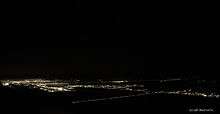
Jebel Hafeet is about 26 km (16 mi) long and 4–5 km (2.5–3.1 mi) wide, extending from north to south. The range is asymmetric, and in the eastern part is much steeper (25 to 40 degrees) than the western side. The mountain rises 1,249 m (4,098 ft), and offers a view over the city. Jebel Hafeet was a well-known landmark throughout the area's history, and is a contemporary tourist attraction. An extensive natural cave system winds through Jabal Hafeet.
Geology
The mountain is composed of many distortions of individual layers of rock rich in fossils of plankton, while at the foot of the mountain it is possible to find various marine fossils including as coral or crabs). Jebel Hafeet is crossed by a system of caves, some of which have been explored to a depth of no more than 150 m (490 ft). In the caves there are well-preserved stalagmites and stalactites. Access to the caves is partly natural, while in other parts of the city of Al Ain, the entrance is blocked. At the foot of Jebel Hafeet lies the "Green Mubazarrah". Green Mubazzarah is a major tourist attraction, with several hot springs flowing into small streams and forming a lake, while pools and hot tubs are spread throughout the area.
Flora and fauna
The mountain is home to endangered species.[7][8]
On the mountain has been observed the yellow bloom of Acridocarpus orientalis. Numerous other plants have been seen around caves in the mountain.
The caves of Jebel Hafeet are a natural habitat for a wide range of animals, including bats, foxes, snakes, rodents, and hyraxes. The lizard Acanthodactylus opheodurus, which until 1982 was considered extinct in the UAE, has been observed in the area. Among the birds, there is the greatest biodiversity of the whole country: a study counted 119 species of birds. Finally, they have been cataloged, with about 200 different insects, and 23 species of butterflies. Recently, seven species of lacewing insects were discovered here. They were previously thought not to have been in this country, but in Saudi Arabia.[8] The Arabian tahr is also found here.[7][9][10]
In 1949, an Arabian leopard was spotted here by Wilfred Thesiger. In 1976, one was shot and wounded, as reported by Hellyer, who claimed another sighting in 1993. The leopard is now possibly extinct in the country's wilderness. In addition, rock hyrax were recently introduced here, and could serve as prey for the leopard, if the latter had to be re-introduced.[1][2]
Archaeology
| UNESCO World Heritage site | |
|---|---|
|
An alley at the Al Ain Oasis | |
| Official name | Cultural Sites of Al Ain (Hafit, Hili, Bidaa Bint Saud and Oases Areas) |
| Location | Al Ain, United Arab Emirates |
| Criteria | Cultural: (iii)(iv)(v) |
| Reference | 1343 |
| Inscription | 2011 (35th Session) |
| Area | 4,945.45 ha (12,220.5 acres) |
| Buffer zone | 7,605.46 ha (18,793.5 acres) |
At the foothills of the mountain, 500 tombs were excavated that dated to an area named after the mountain, the early bronze age Hafit period of between 3200 and 2600 BC. These Tombs were firstly discovered in 1950. Later excavations by Danish archaeologists in 1959 found evidence for ceramic vessels and copper artifacts in these tombs. While the graves on the north side have been partially destroyed by construction projects, the southern tombs are preserved. Some of the tombs contain skeletons, some of which are adorned with bronze objects and pearls. Other objects found in the tombs include ceramics from Mesopotamia, witness to trading relationships in antiquity. Because of its exceptional archaeological and historical value, in 1993, the "Desert Park and the tombs" (which includes the Jebel Hafeet) was inscribed on the list of UNESCO World Heritage Sites as the "Cultural Sites of Al Ain: Hafit, Hili, Bidaa Bint Saud and Oases Areas".[11]
Tourism

Jebel Hafeet is a popular tourist center with a broad view over the whole area from the summit. At the foot of the mountain lies the Green Mubazzarah, a well-developed tourist attraction featuring a geyser, a children's play park and a number of chalets for hire. At the Green Mubazzarah, hot-water springs gush forth in little streams and form a lake. Swimming pools and jacuzzis are scattered all over the Green Mubazzarah. On top of the mountain, there is a military communications outpost and a hotel operated by French hospitality company Mercure,[12] as well as a palace.
Hafeet Mountain Road
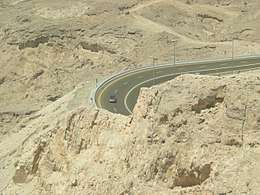
The Jebel Hafeet Mountain Road, built in 1980, extends for 11.7 km (7.3 mi) up the mountain, rising 1,200 m (3,900 ft). With 60 turns and three lanes (two climbing and one descending), the road was called the greatest driving road in the world by Edmunds.com.[13] The road scales the mountain and ends at a parking lot with a hotel and a palace belonging to the country's rulers. Part of the climax of the Bollywood film Race was shot on the mountain.
The road was built by Strabag International of Cologne, Germany.
Hafeet Mountain Road is a challenge for cyclists who frequently use the route to train. The Jabal Hafeet Mercure Challenge is an annual road cycling competition taking place in January. National and international riders take part in climbing the 8% average ascent of the mountain.[14] In 2015 it hosted the arrival of the third stage of first edition of Abu Dhabi Tour, a cycling race organized by RCS Sport, won by Colombian Esteban Chaves.
Gallery
- The area of the mountain at night
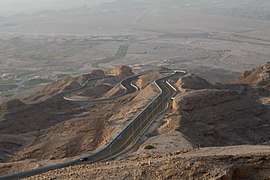 Another road leading to the mountain
Another road leading to the mountain
See also
References
- 1 2 3 4 Edmonds, J.-A.; Budd, K. J.; Al Midfa, A. & Gross, C. (2006). "Status of the Arabian Leopard in United Arab Emirates" (PDF). Cat News (Special Issue 1): 33–39.
- 1 2 3 4 Spalton, J. A. & Al-Hikmani, H. M. (2006). "The Leopard in the Arabian Peninsula – Distribution and Subspecies Status" (PDF). Cat News (Special Issue 1): 3–47.
- ↑ Brian McMorrow, JabalHafeet.
- ↑ 1968-, Magee, Peter,. The archaeology of prehistoric Arabia. New York. ISBN 1316003183. OCLC 879421807.
- 1 2 "UAE Tours - Jebel Hafeet". www.vjcyber.com. Retrieved 2018-09-30.
- 1 2 "Jebel Hafeet climate: Average Temperature, weather by month, Jebel Hafeet weather averages - Climate-Data.org". en.climate-data.org. Retrieved 2018-09-30.
- 1 2 WAM (2017-09-13). "EAD raises awareness on Abu Dhabi's natural heritage at ADIHEX 2017". The Gulf Today. Retrieved 2018-03-30.
- 1 2 Al-Wasmi, N. (2017-02-15). "Jebel Hafeet boost for local biodiversity". The National. Retrieved 2018-04-03.
- ↑ De Leon, J. P. (2014-05-26). "100th Arabian tahr, and twin tahrs welcomed in Al Ain". Gulf News. Retrieved 2018-04-03.
- ↑ "Newborn Arabian tahr discovered on Jebel Hafeet". The National. 2015-03-12. Retrieved 2018-03-30.
- ↑ "Cultural Sites of Al Ain (Hafit, Hili, Bidaa Bint Saud and Oases Areas)", Unesco, 2011-06-27
- ↑ "Mercure Grand Jebel Hafeet Al Ain". Mercure Hotels.
- ↑ Gautam Sharma (2015-01-29). "Great driving roads: Jebel Hafeet Mountain Road, Al Ain". The National.
- ↑ "Jebel Hafeet Mountain Road". dangerousroads.org. 2011-03-29.
External links
| Wikimedia Commons has media related to Jebel Hafeet. |